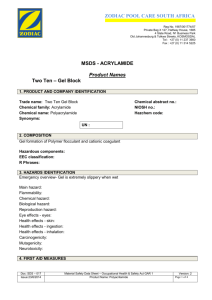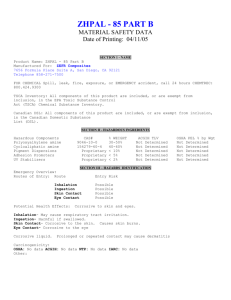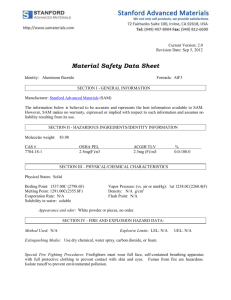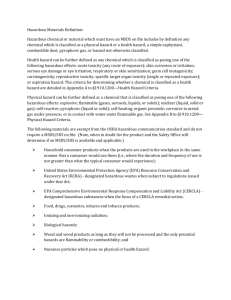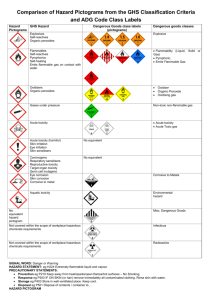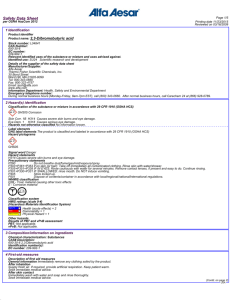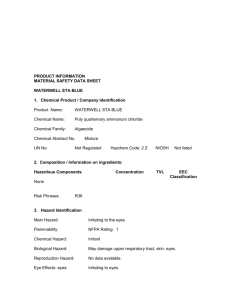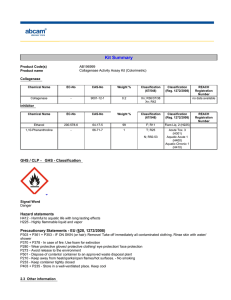Two Ten Chemicals (Pty) Ltd Distributors of pool care products
advertisement
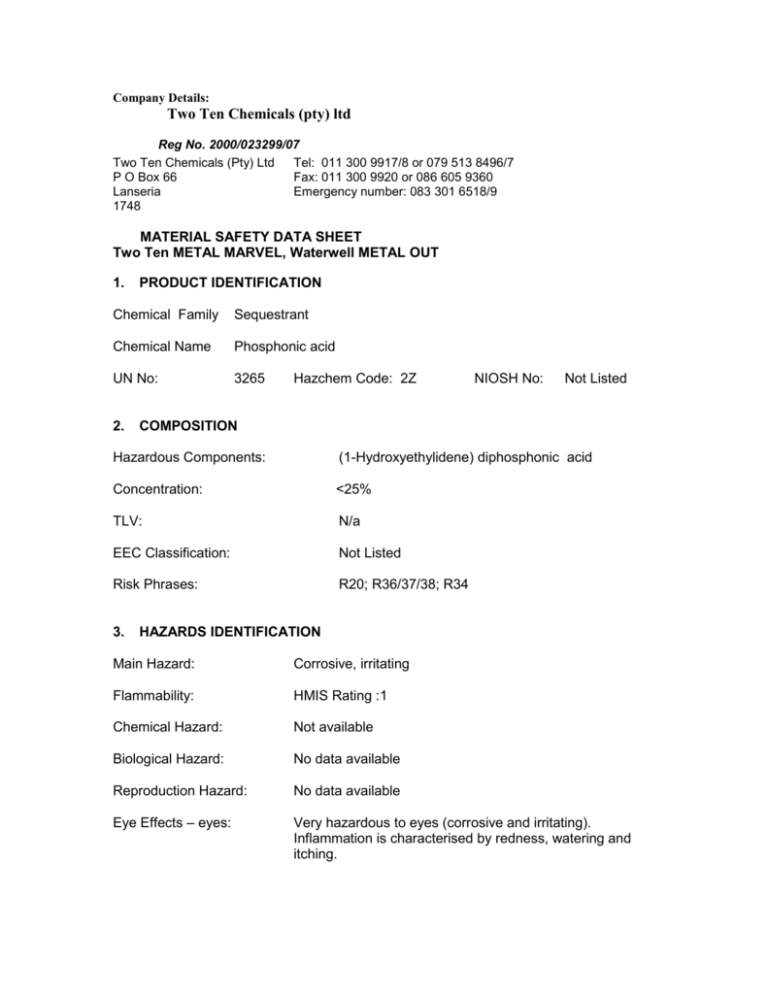
Company Details: Two Ten Chemicals (pty) ltd Reg No. 2000/023299/07 Two Ten Chemicals (Pty) Ltd Tel: 011 300 9917/8 or 079 513 8496/7 P O Box 66 Fax: 011 300 9920 or 086 605 9360 Lanseria Emergency number: 083 301 6518/9 1748 MATERIAL SAFETY DATA SHEET Two Ten METAL MARVEL, Waterwell METAL OUT 1. PRODUCT IDENTIFICATION Chemical Family Sequestrant Chemical Name Phosphonic acid UN No: 3265 2. Hazchem Code: 2Z NIOSH No: Not Listed COMPOSITION Hazardous Components: (1-Hydroxyethylidene) diphosphonic acid Concentration: <25% TLV: N/a EEC Classification: Not Listed Risk Phrases: R20; R36/37/38; R34 3. HAZARDS IDENTIFICATION Main Hazard: Corrosive, irritating Flammability: HMIS Rating :1 Chemical Hazard: Not available Biological Hazard: No data available Reproduction Hazard: No data available Eye Effects – eyes: Very hazardous to eyes (corrosive and irritating). Inflammation is characterised by redness, watering and itching. Health Effects – skin: Hazardous to skin (irritating). Skin contact may produce burns. Inflammation characterised by itching, scaling, reddening or occasionally blistering. Health Effects – ingestion: Not expected to be the primary route of exposure. Expected to be moderately toxic by ingestion. Health Effects – inhalation: May be harmful if inhaled. Do not breathe spray mists of the undiluted product. Effects will depend on strength of solution and length of time of exposure. Carcinogenicity: Refer Section 11 ; Toxicological Information Mutagenicity: Refer Section 11 ; Toxicological Information Neurotoxicity: Refer Section 9 ; Physical and Chemical Properties 4. FIRST AID MEASURES Product in the eye: Flush immediately with copious amounts of tap water or normal saline solution for a minimum of 15 minutes. Take exposed individual to a physician, preferably an opthalmologist, for further evaluation. Product on the skin: Wash exposed area with plenty of water. Repeat washing. Remove contaminated clothing and wash thoroughly before reuse. If irritation persists, consult a physician. Product ingested: DO NOT INDUCE VOMITING. Rinse with copious amounts of water or milk first. Irrigate the oesophagus and dilute stomach contents by slowly giving one (1) or two (2) glasses of water or milk. Avoid giving alcohol or alcohol related products. In cases where the individual is semi-comatose, comatose or convulsing, DO NOT GIVE FLUIDS BY MOUTH. In case of intentional ingestion of the product, seek medical assistance immediately; take individual to nearest medical facility. Inhalation: If exposure by inhalation is suspected, immediately move exposed individual to fresh air. If individual experiences nausea, headache, dizziness, has difficulty in breathing or is cyanotic, seek medical attention immediately. NOTE TO PHYSICIAN: 5. No product specific antidote is known. Probable mucosal damage may containdicate the use of gastric lavage. Treat symptoms. For specialist medical advice in the event of an emergency contact 031-560 5288. FIRE FIGHTING MEASURES Extinguishing Media: Water spray, carbon dioxide, alcohol-resistant foam, dry chemical powder. Never use water jet. Special Hazards: Non-flammable aqueous solution. The residue will burn after the water has evaporated. Decomposes in a fire giving off irritant fumes and vapours: CO, CO2, Pox. Protective Clothing: Fire-fighters should wear positive pressure self-contained breathing apparatus and full turnout gear. 6. ACCIDENTAL RELEASE MEASURES Personal Precautions: Rubber gloves and safety glasses or goggles required. Eye wash fountains in the work place are strongly recommended. Body-protective clothing and shoes are recommended. If splashing can occur, the use of a face shield is recommended. Use a self-contained breathing apparatus where misting may occur. Environmental Precaution: Do not discharge concentrated, undiluted product into lakes, streams, ponds, estuaries, oceans and other waters. Spills: Liquids: Dam area to prevent spill from spreading. Clay, soil or commercially available absorbents may be used to recover any material that cannot be recovered as pure product. Liquids/Solids/Powder: Minimise adverse effects on the environment. Recover as much as possible of the pure product into appropriate containers. Later, determine if this recovered product can be used for its intended purpose. Dispose of in an approved landfill. 7. HANDLING AND STORAGE Suitable Material: Handling/Storage Precautions: Polypropylene, Teflon, PVC-rigid, Buna-N rubber, Viton, PVC-flexible, Silicone rubber, Tygon tubing R3603, Van Leer epoxy liner 136, Polyethylene. The handling precautions for this product are based on the characteristics of the neat product unless otherwise specified. Store in a cool dry place. Rubber gloves and safety goggles are required. Body-protective clothing and safety shoes are required. Eye-wash fountains in the work place are strongly recommended. 8. EXPOSURE CONTROLS/PERSONAL PROTECTION Occupational Exposure Limits: None Engineering Control Measures: Provide local exhaust ventilation. Personal Protection – Respiratory: In case of insufficient ventilation, wear-suitable respiratory equipment. Personal Protection – Hand: Rubber gloves. Personal Protection – Eye: Safety goggles are required. Personal Protection – Skin: Body-protective clothing and safety shoes are recommended. Where splashing can occur, a protective face-shield is required. Other Protection: Eye wash fountain in the workplace is strongly recommended. 9. PHYSICAL AND CHEMICAL PROPERTIES Appearance: Clear colourless to pale yellow liquid. Odour: Slight characteristic. Ph: < 2 (1% soln). Boiling Point:: >100C Melting Point: -25C Flash Point: >100C (Tagliabue c.c) Flammability: HMIS Rating : 1 Autoflammability: Not available. Explosive Properties: Not available. Oxidising Properties: None. Vapour Pressure: Density: 1,44 – 1,46 g/ml Solubility in Water: Completely miscible in water. Solubility-solvent: Solubility Coefficient: Neurotoxicity: 10. STABILITY AND REACTIVITY Conditions to avoid: Stable under normal conditions of use and storage. Incompatible Materials: Strong oxidisers, strong bases. Attacks many metals with liberation of hydrogen which is inflammable and forms explosive mixture with air. Hazardous Decomposition Products: Combustion decomposition : CO, CO2, Pox. Acids of phosphorous. 11. TOXICOLOGICAL INFORMATION Acute Toxicity Oral LD50 (rat) = 2000 mg/kg. Dermal LD50 (rat) = 3 500 mg/kg: (rabbit) = 10 000 mg/kg. Skin and Eye Contact: Very hazardous to eyes and hazardous to skin. Chronic Toxicity: Repeated exposure to the concentrated product may cause damage to the following organs: blood, gastrointestinal tract, upper respiratory tract, skin, eyes, bones. Carcinogenicity: Not listed in any of OSHA Standard, Section 1910. 1200 sources as carcinogenic; not tested by Buckman Laboratories, Inc. Mutagenicity: No data available. Reproduction Hazard: No data available. 12. ECOLOGICAL INFORMATION Aquatic Toxicity – Fish: 96 hr. LC50: Rainbow trout = 368 mg/1; 96 hr. LC50: Bluegill sunfish = 868 mg/l ; 96 hr. LC50: Sheepshead minnow = 2180 mg/l. Aquatic Toxicity: Not toxic to aquatic organisms and not suspected of long-term adverse effects in the aquatic environment. 48 Hr. EC 50: Daphnia magna = 527 mg/l ; 96 Hr. EC50: Grass shrimp = 1770 mg/l. Aquatic Toxicity – Algae: Not available. Avian Toxicity: Oral LD 50: Mallard duck = . 2 510 mg/kg bw. Oral LD 50: Bobwhite quail = > 2 510 mg/kg bw. Not classified as harmful to birds. Biodegradability: Bio – Accumulation: Mobility: German wgk: 13. DISPOSAL CONDITIONS Disposal Method Product is hazardous waste due to pH. Dispose in an approved landfill. Disposal of Packaging: Dispose of drums through a registered drum reconditioning company. Dispose of packaging other than drums, e.g. Flexi-bags, through a registered waste disposal company in an approved landfill. 14. TRANSPORT INFORMATION Un No.: 3265 Substance Identity No.: 3265 Dot Class: 8 Corr. Liquid, acidic, organic n.o.s. ADR/RID Class: 8 Corr. Liquid, acidic, organic. ADR/RID Item Number: Not available. ADR/RID Hazard Identity Number: Not available. IMDG – Shipping Name: Corr. Liquid, acidic, organic n.o.s. IMDG – Page: 8147-1. IMDG – Class: 8 Corr. Liquid, acidic, organic n.o.s. IMDG – Packaging Group: IMDG – Marine Pollutant: III No EMS No.: 8-15 MFAG Table No.: 760,4.3 IATA – Shipping Name: Corr. Liquid, acidic, organic n.o.s. IATA – Class: 8 Corrosive Liquid IATA – subsidiary risk(s): None ADNR – Class: 8 Corrosive Liquid UK – Description: 8 Corrosive Liquid UK – Emergency Action Class: 153 UK – Classification: 8 Corrosive Liquid Tremcard No: BLB7016 15. REGULATORY INFORMATION EEC – Hazard Classification: Not Listed Risk Phrases: R20; R36/37/38; R34 Safety Phrases: S26; S62; S28 National Legislation: None known FDA Approvals: 173.310 (Boiler water additives) 16. OTHER INFORMATION The information on this Material Safety Data Sheet reflects the latest information and data that we have on hazards, properties, and handling of this product under the recommended conditions of use. Any use of this product or method of application which is not described in the Product Data Sheet is the responsibility of the user. Revision No : MSDS – 05 03 March 2004


